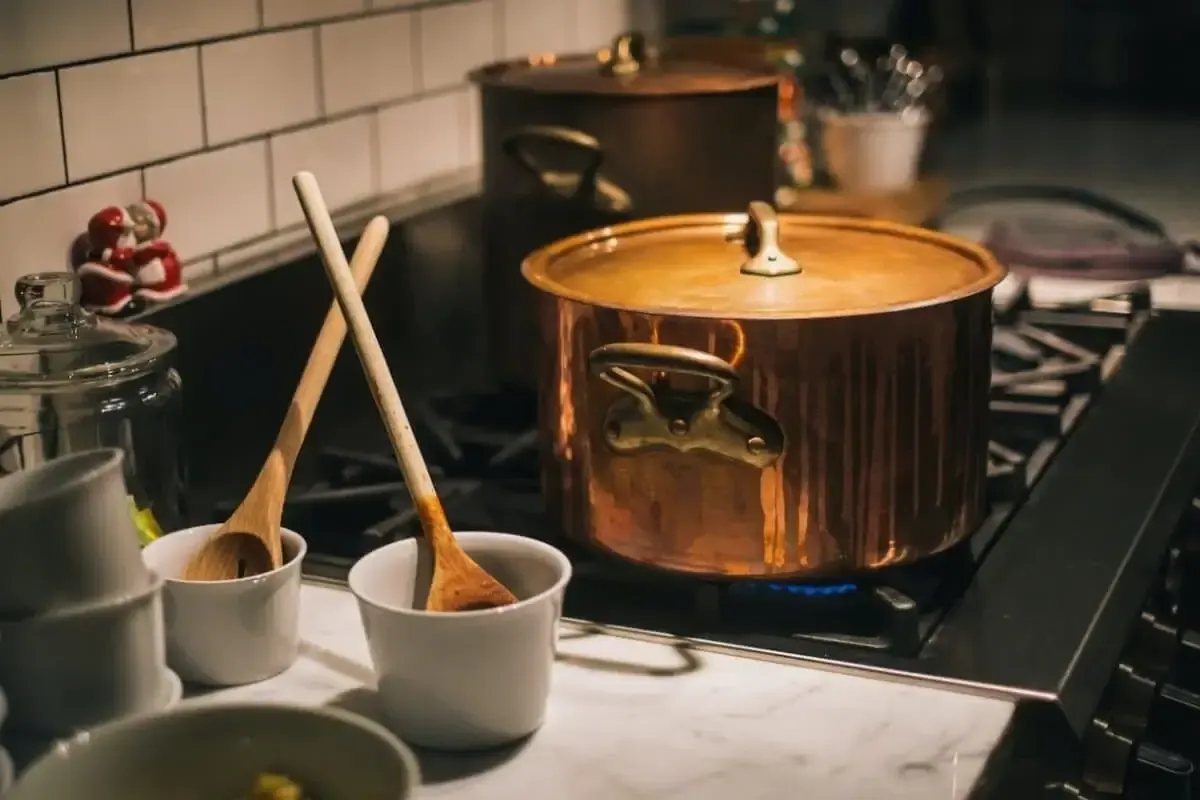Our Top Picks
-
Best Cookware Set Overall: Made In Cookware Stainless Steel 10-Piece Set
-
Best Nonstick Cookware Set: Circulon A1 Nonstick 10-Piece Set
-
Best Value Cookware Set: Ninja Foodi NeverStick 8-Piece Set
-
Best Ceramic Cookware Set: GreenPan Valencia Pro Ceramic 11-Piece Set
-
Best Premium Cookware Set: Hestan Nanobond Titanium 10-Piece Set
-
Best Stainless Steel Cookware Set: All-Clad D3 Stainless Steel 10-Piece Set
-
Best Nontoxic Cookware Set: Caraway Nonstick Ceramic 12-Piece Set
How to Choose the Right Cookware Set
Starting your culinary journey requires the right tools, but selecting your suitable cookware set can feel overwhelming. This master guide will break down any information you need to consider so that you can buy the cookware set that’s right for you.
Basic Pieces of Cookware
1. Frying pans/Skillets
Frying pans typically have a wide base and short sides. Whether you’re making omelets to sautéing vegetables, the slanted sides of frying pans let you stir and flip ingredients quickly, perfect for quick cooking.
Frying pans are available in a variety of sizes, often from 8-inch to 12-inch. It’s helpful to have a few options in your kitchen to match the size of your meal and the number of people you’re looking to feed.
2. Dutch ovens
Dutch ovens are one of the most versatile, timeless and durable types of cookware. They’re designed to go from stovetop to oven, and straight to the table.
A Dutch oven is a lidded pot with handles, making them perfect for soups, roast chicken and even baked bread. Traditionally made from heavy durable materials like enamel cast iron, Dutch ovens are now available in nonstick, lighter and more affordable versions.
3. Sauce pans
A sauce pan is one of the most essential tools in any kitchen, with its long handle, high straight sides and lid. Rather than just making sauces, you can use the sauce pan to make gravy and syrups, reheat soup, prepare rice and potatoes, and boil or steam vegetables.
Sauce pans are usually measured by volume and come in a range of sizes, often from a small 1 quart up to a large 4 quart.
4. Roasters/Roasting pans
A roasting pan is an ideal vessel for cooking large cuts of meat like a Thanksgiving turkey, a leg of lamb or a simple roast chicken. These pans come in various sizes and are available in rectangular and oval shapes.
A roasting pan often includes a rack that holds the meat above the pan, allowing hot air to circulate evenly and drippings to flavor ingredients like potatoes and onions below.
Some Specialty Pieces of Cookware
1. Griddles
Griddles are flat pans that transform your cooktop into a large flat cooking surface.
They are so useful for breakfast foods like French toast, pancakes, eggs and bacon, but they’re also great for searing steaks, making fajitas, or reheating pizza.
2. Grill pans
A grill pan can help you enjoy grilled flavors right on your stovetop. These pans allow you to make kebobs, grilled chicken, veggies, brats and more. Grill pans are usually available in cast iron or non-stick finishes.
3. Lasagna pans
A lasagna pan is a type of rectangular bakeware, often 9"x13” pan or larger. It’s ideal for baking up a large lasagna, but can also be used for mac and cheese, shepherd’s pie or desserts.
These pans often feature rounded edges for easier serving.
4. Pasta cookers
Also called pasta pots or multipots, pasta cookers are large stock pots with a perforated insert so you can easily drain pasta. Some models come with an additional perforated basket that can be used for steaming vegetables, fish or dumplings.
5. Sauciers
Sauciers are similar to saucepans but offer a few key design differences. Sauciers have curved rounded edges and shorter sides. A saucier will be a better pan for dishes that require constant stirring like risotto, custards or delicate sauces.
6. Sauté pans
Looking similar to a frying pan, a sauté pan has straight sides, which help contain liquids and reduce splatter. Many sauté pans are oven-safe.
7. Steamers
Steaming is a quick and healthy cooking method to cook your food and there are a variety of steamers to choose from. A pasta pot or multipot can function as a steamer, especially if they have a perforated insert, while separate steam baskets can be used with a pot you already have.
8. Stock & Soup pots
These pots are large enough to boil lots of water or simmer a big batch of soup for meal prep. Typically made from stainless steel or nonstick materials, they are often lighter than dutch ovens of a similar size. This makes them a great choice if you are looking for a large volume pot but don't want it to be too heavy.

Cookware Materials
1. Aluminum
Plain aluminum cookware is inexpensive, lightweight and heats up quickly. But aluminum can be soft, does not retain heat well and can react with acidic foods like tomatoes or lemon juice, this could harm the pan or leach aluminum into your food.
It’s also not compatible with induction cooktops. However, because aluminum is an efficient conductor of heat, you also find it used inside aluminum core cookware or in stronger forms like hard-anodized aluminum, which solves many of these issues.
2. Carbon steel
Like cast iron, carbon steel is known for its durability, but it is lighter and heats up faster. Made from carbon and iron, carbon steel is induction compatible but it can still react with highly acidic foods.
You’ll most often find it used for frying pans and woks because it handles high-heat cooking where you move the pan around. Carbon steel pans do require seasoning to build a natural nonstick surface.
3. Cast iron
Cast iron is affordable, lasts a lifetime, and can handle very high heat for searing, frying, for baking bread, slow-simmering stews and slow-roasting meats. When properly seasoned (coated with oil and heated), it develops a natural, chemical-free, nonstick surface.
Cast iron cookware is heavy, heats slowly but evenly and can even be used on an outdoor grill.
4. Ceramic
Ceramic-coated cookware is a non-stick cookware option made without PTFE and PFOA. They require little to no oils for cooking. Most ceramic cookware can go in the oven at low to medium heat.
5. Copper
Copper cookware heats up very quickly and responds instantly when you change the temperature. For most modern copper cookware, copper is the material used in the core or on the exterior with a stainless steel cooking surface that prevents food from reacting with the copper. Some copper pans have a magnetized base which makes them compatible with induction cooktops.
6. Enameled cast iron
Enameled cast iron is cast iron coated with a layer of smooth, porcelain enamel. This coating helps prevent rust, makes cleaning easier and requires no seasoning.
Enameled cast iron works best at low to medium heats. Very high temperatures can leave scorch marks. It does not hold odors or flavors and won’t react with acidic foods.
7. Hard-anodized
Most hard-anodized cookware is coated with a non-stick finish so you can cook almost anything in them. In the anodizing process, aluminum is altered to create a stronger, more durable and non-reactive material.
8. Non-stick
Non-stick cookware is loved for its easy food release and quick cleanup. You can cook with little to no oil, perfect for foods that are prone to sticking like eggs, pancakes, fish, crepes and more.
Stainless steel cookware is non-reactive with high-acidic foods. Most have a multi-ply construction with a thick aluminum or copper core for excellent heat distribution. The polished interior won’t discolor from food, and the shiny exterior is often magnetic.
Other Factors to Consider
- Budget: Set a spending limit and stick to it. Don’t strain your finances for a pricey set.
- Durability: Choose long-lasting cookware if you’ll use it often. For occasional use, durability matters less.
- Maintenance: Some materials, like copper or cast iron, need extra care. If you prefer low maintenance, go for stainless steel.
- Cooking Style: Match cookware to your go-to methods. Cast iron is great for frying; avoid unlined copper for slow cooking.
- Appearance: Pick a style that suits your kitchen, from classic copper to colorful modern designs.
- Cooktop Type: For induction, choose magnetic cookware.
Why You Should Trust Us
When it comes to choosing the best cookware sets, you need advice that’s clear, reliable, and based on real kitchen know-how. That’s why we’re here, helping you find cookware you will love using.
We keep things honest and straightforward, cutting through the noise with real expertise. Our recommendations are built on years of culinary experience, thorough research into materials and designs, and a deep understanding of how different cookware performs in everyday cooking.
Every cookware set we highlight has proven its worth, so you can invest in your perfect companion that will serve you for years.
Final Thoughts
Choosing well-crafted cookware sets will pay off with better-tasting meals and a more efficient cooking experience. This guide has covered what to consider before making a decision to buy any cookware set, and also recommends some outstanding picks that will help you cook with confidence and efficiency.
Among our top picks, Made In Cookware Stainless Steel 10-Piece Set shines for its professional-grade construction, excellent heat distribution, deserving as the best overall set. For those who are ceramic cookware lovers, GreenPan Valencia Pro Ceramic 11-Piece Set strikes a great balance between performance and health-conscious cooking.
FAQs
1. What pieces are usually included in a cookware set?
Typical sets include saucepans, fry pans, sauté pans, stockpots, and matching lids. Some may include extras like steamer inserts or utensils.
2. Is it better to buy a set or individual pieces?
Sometimes yes. If you're starting from scratch, a set offers better value. But if you cook specific dishes, choosing individual pans (like a cast iron skillet or stockpot) may suit you better.
3. Are ceramic cookware sets safer or healthier than nonstick?
Yes. ceramic coatings are free of chemicals like PTFE and PFOA and are generally considered safer alternatives to traditional nonstick coatings.
4. Can I use metal utensils on nonstick cookware?
Not recommended. Avoid metal utensils on nonstick and ceramic to prevent scratching. Stainless steel, cast iron, and hard-anodized sets generally allow metal utensils without damage.
5. How should I maintain my cookware?
Maintenance depends on material: cast iron requires; ceramic and nonstick pans benefit from gentle cleaning; stainless steel and hare-anodized sets are often dishwasher safe but handwashing extends life.




















